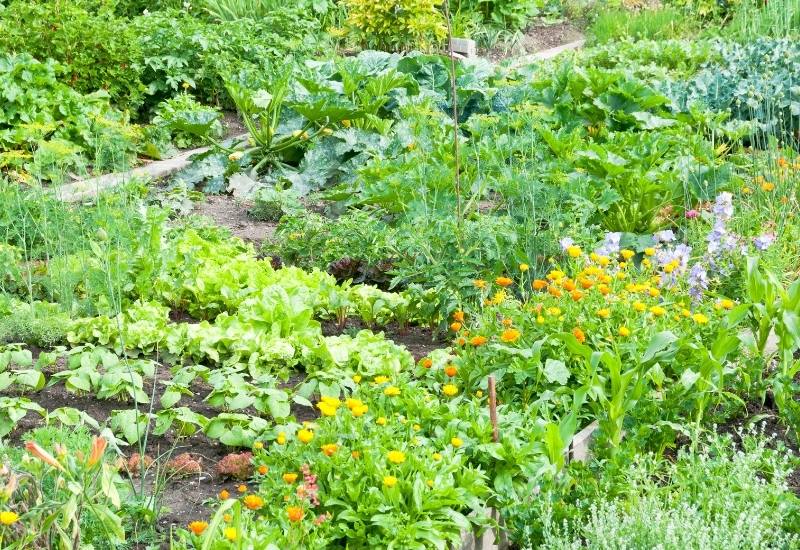
Marigolds belong in every vegetable garden, and that’s not an exaggeration. Gardeners quickly learn that marigolds offer several benefits to vegetable gardens that cannot be ignored.
Marigolds look lovely no matter where you plant them. They look great in hanging baskets, containers, planters, and garden borders. They also make a great addition to vegetable gardens.
Don’t confuse marigolds with calendula, which is sometimes called pot marigolds. While calendula is just as beautiful as marigolds, this is about marigolds, and they offer different benefits than calendula.
Many gardeners never think to add flowers to their vegetable garden, but polycultures of vegetables, fruits, herbs, and flowers encourage and aid in organic gardening.
Let’s look at why you should consider companion planting marigolds in a vegetable garden and how to do so.
Top 10 Benefits of Planting Marigolds in Vegetable Garden
1. Attracts Bees And Other Pollinators
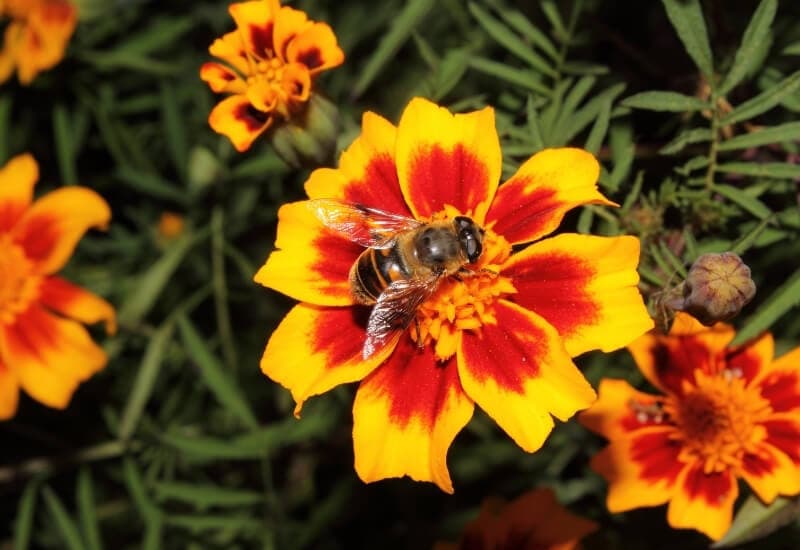
The most common benefit of planting marigolds in a vegetable garden is that they attract bees and pollinators.
Marigolds bloom over a long period, typically the entire summer and early fall. That means that their blooms are a source for bees and other pollinators.
If you plant marigolds with a primary goal to attract bees, note that bees before the single-bloom varieties over the double because it makes it easier to reach the blooms for the bees.
2. Repel Some Pests
Another benefit of planting marigolds is that many gardeners swear marigolds repel many pests when planted in a vegetable garden.
We know that the claims that marigolds repel deer or rabbits are wrong, but evidence shows marigolds do repel some pests, such as cabbage moths and Mexican bean beetles.
One of the reasons why marigolds might be so helpful in repelling pests is their strong scent. Chances are, it masks the smell of your vegetable plants, causing pests and predators to head the other way.
3. Protect Tomatoes
Marigolds and tomato plants are best friends, so planting them near tomatoes adds an essential protection layer.
It’s shown to repel nematodes, slugs, tomato hornworms, and other pests that love to munch on tomatoes.
4. Ward Off Harmful Nematodes
Thousands of nematode species exist, but a few are incredibly damaging to garden crops. Fighting nematodes is difficult, if not impossible, so the best choice is to use them as a companion plant to stop nematodes from invading the soil.
It’s said that marigolds help out neighboring plants by killing nematodes. However, there is a lot of confusion around this topic, and not everyone believes it works.
Marigolds produce a compound in their roots that are used in nematicides. That being said, a wide range of nematodes exist, and it’s hard to determine your particular problem.
The good thing is that, whether or not they genuinely ward of nematodes, adding marigolds won’t harm your garden, so give it a whirl anyway.
5. Companion Plants For Many Vegetables
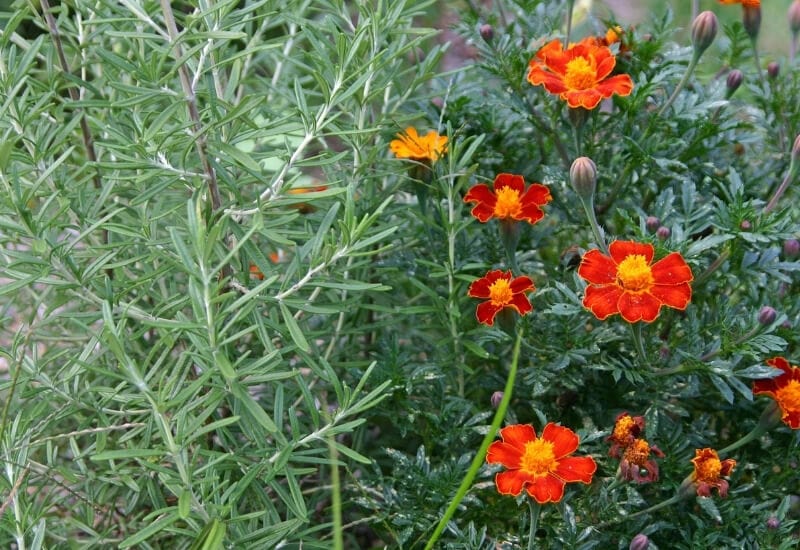
Marigolds are an excellent addition to most vegetable gardens because they’re a companion plant to bush beans, potatoes, broccoli, squash, eggplant, and kale.
For many other plants, marigolds are considered a neutral companion, which means they’re neither harmful nor beneficial so that they can be planted in many garden areas.
6. Add Color And Beauty
Everyone appreciates a bit of color and beauty. If you’ve never grown flowers with your vegetable plants, you’re missing out.
They add pops of color and bring beauty to a garden that’s typically all green. They’ll bring smiles to your face each time you walk into your garden.
7. Low Maintenance Flower
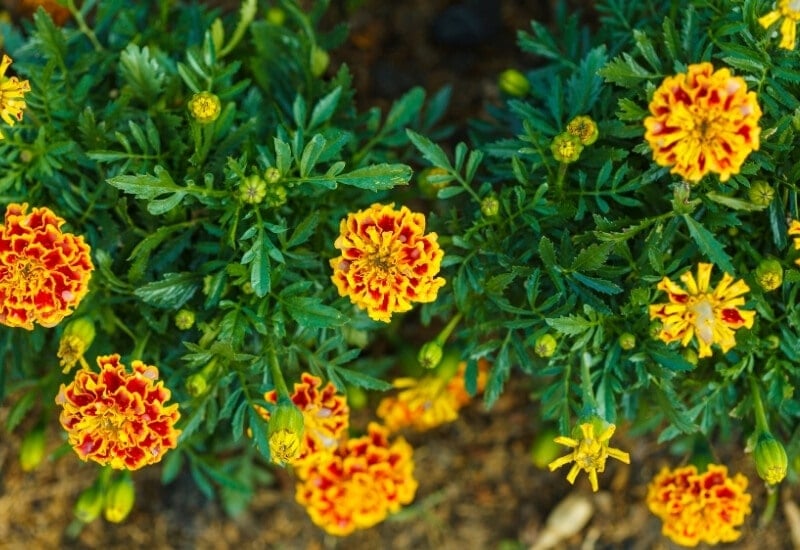
Can you think of a flower that’s easier to grow than marigolds? Marigolds are so easy to grow and grow well in a range of soil types and conditions.
As long as they have plenty of sunlight, they continue to grow and thrive with little to no help from you.
8. Marigolds Are Edible
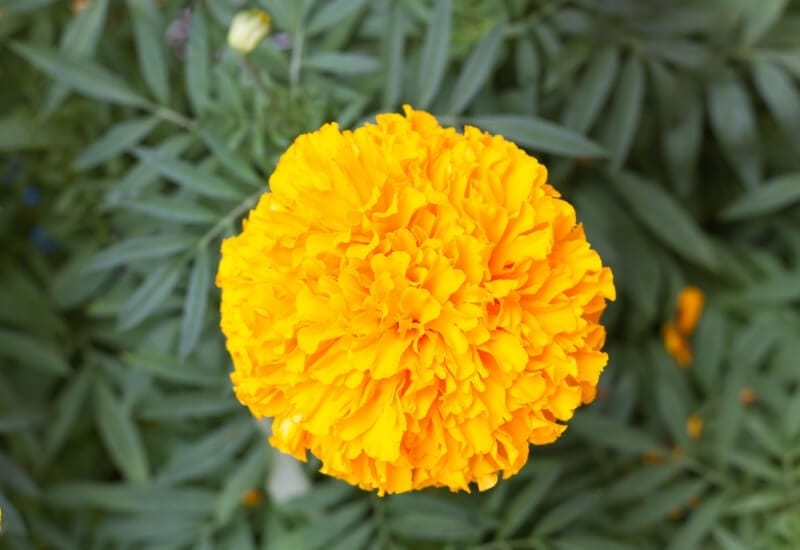
Yes, you read that correctly. Most people have no idea that these easy to grow flowers are edible as well. That means they’re more than a companion plant; they’re an edible crop as well.
Add marigold petals to salads, use them as a decoration on cakes or cupcakes, or make a vinaigrette featuring marigold petals. You might be surprised by all the ways that marigolds can be used in the kitchen.
9. Act As An Effective Trap Crop
Some gardeners say that marigolds might be a useful trap crop for specific pests. This means that they lure pests to them, keeping them away from valuable crops.
An example is slugs, which love marigolds. Planting many marigolds around garden beds that contain other plants that slugs love can save them from certain death.
10. Medicinal Properties
Calendula and marigolds belong to the same family, so many of the same properties that calendula has, marigolds do as well.
Marigolds help with skin conditions, rashes, minor wounds, bedsores, eczema, and varicose veins. They also aid in treating sores, inflammation, and itchiness.
Best Vegetables To Companion Plant With marigolds
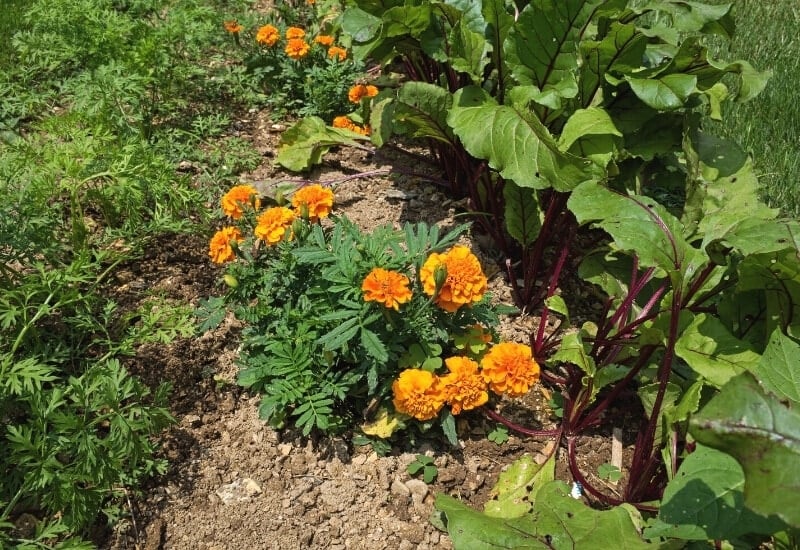
Fact is, many myths surround planting marigolds in a vegetable garden. Science cannot back up all of those claims made, but gardeners for years have said otherwise.
If you put more credit into what experienced gardeners say than the studies, planting marigolds should be just as important as any other crop.
That being said, we do know that marigolds do help some plants. Planting marigolds near any vegetable crop won’t hurt them. For the most part, marigolds are neutral plants, so they don’t do any harmful things.
If you want to tap into the benefits of marigolds, here are the best vegetables that do well with marigold companions:
How to Plant Marigolds in a Vegetable Garden
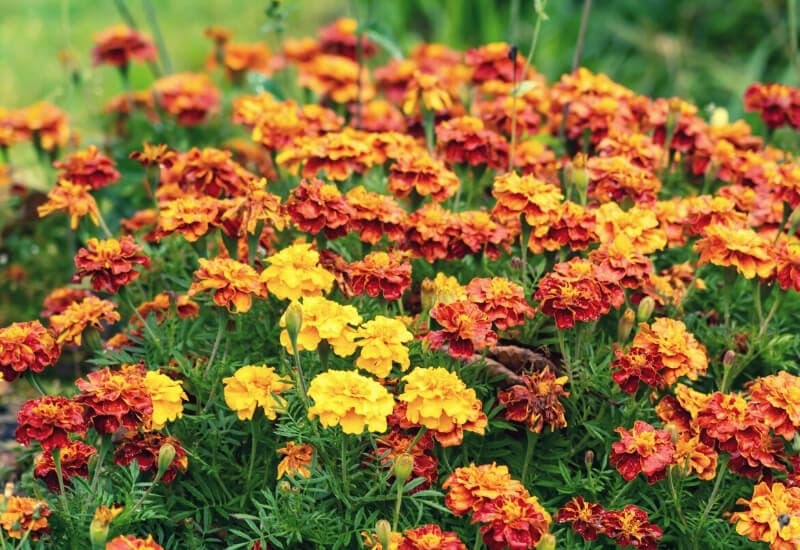
Marigolds come in a range of colors, from cream to bright yellow and variegated reds. They provide the perfect pop of color in your vegetable garden. Marigolds also vary in height from only six inches tall to up to three feet tall.
Here’s how to plant marigolds in vegetable gardens.
1. Make Sure They Have Plenty Of Sunlight
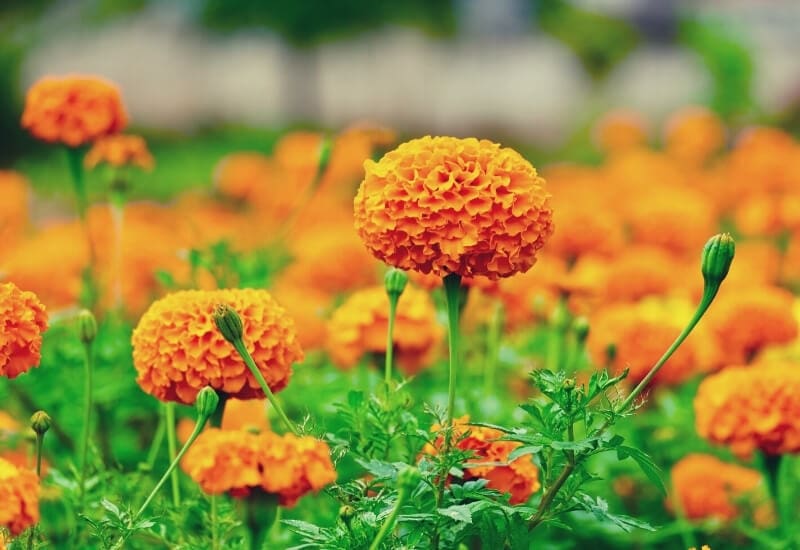
Like many plants, marigolds need full sunlight, around six to eight hours per day. Marigolds do well in hot weather.
If planted in shady areas, marigolds are prone to powdery mildew and failure to bloom. Stick to sunny locations for ideal growth.
2. Decide Where To Plant Marigolds In The Vegetable Garden
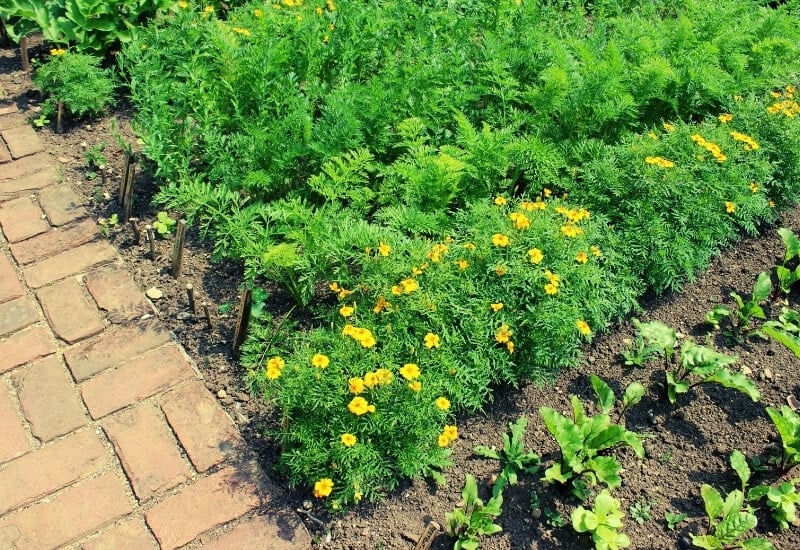
The hardest part about planting marigolds in a vegetable garden is deciding where to put the plants. You have a few options to consider.
Grow In Containers Or Hanging Baskets
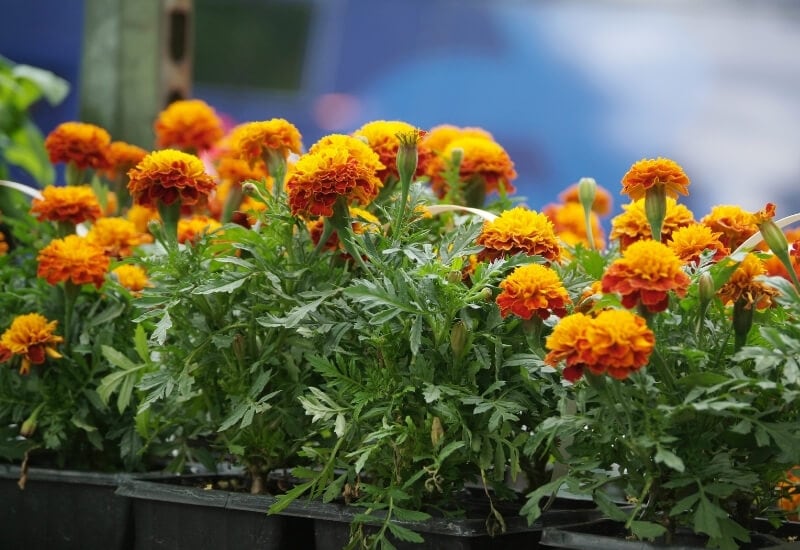
The first option is to put marigolds in containers and hanging baskets throughout your garden. While they won’t be able to enrich the soil this way, their scent still attracts or repels insects.
Strew The Seeds Wildly
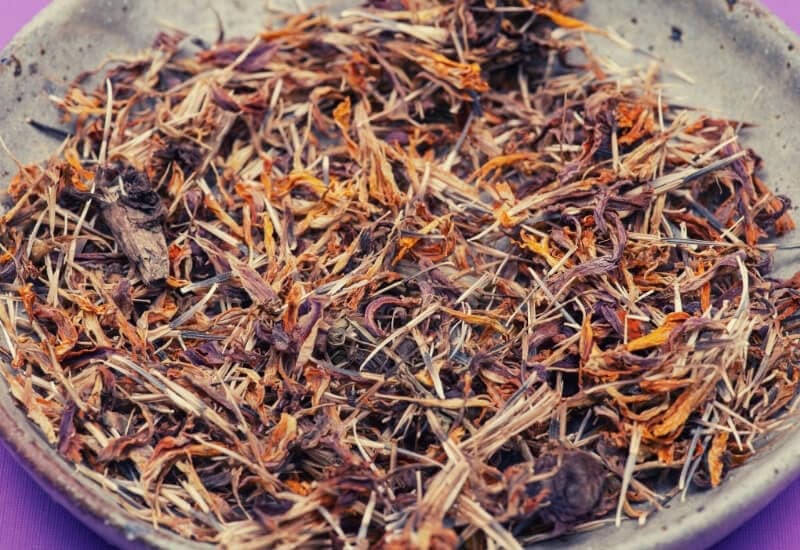
If you want to mimic nature, spread the seeds randomly throughout your vegetable garden. Look for open spaces in front, behind, or between plants.
Plant the seeds or seedlings randomly in clusters or solo. Using this method is best done with one color of marigold, creating a cohesive look.
Create A Border
If you want an orderly look, consider making a row of marigolds around the edges of your garden bed.
You can either drop the seeds along the border or plant a single row of seedlings. A double or triple row will look lush.
Plant Near Specific Plants
For those using marigolds specifically as companion plants, another option is to simply plce them near the plants you want to reap the benefits.
3. Fix The Soil
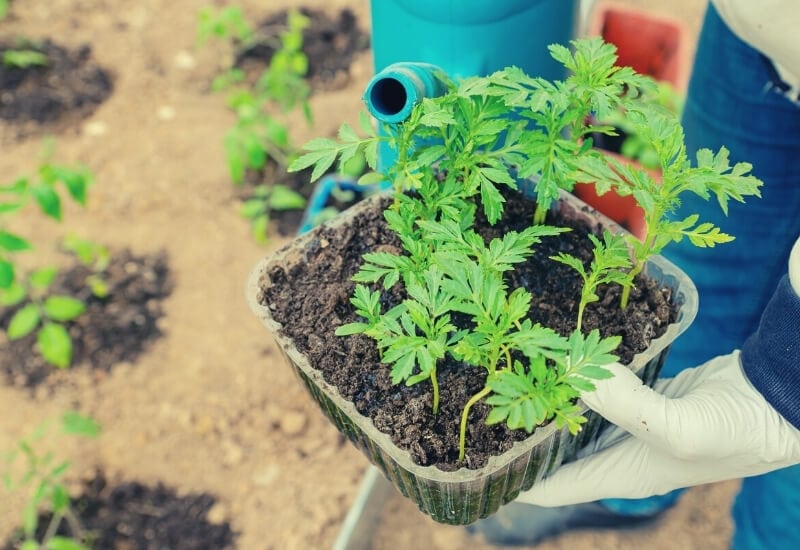
One of the reasons why marigolds are so easy is because they grow in nearly any condition. New gardeners don’t need to stress about creating the idea soil, but it’s a good idea to enrich it with compost before planting. Marigolds grow the best in moderately fertile, well-draining soil.
To prepare the soil, dig and till it up six inches down to loosen everything. Remove any stones or large chunks that might prohibit root growth.
4. Sow Seeds
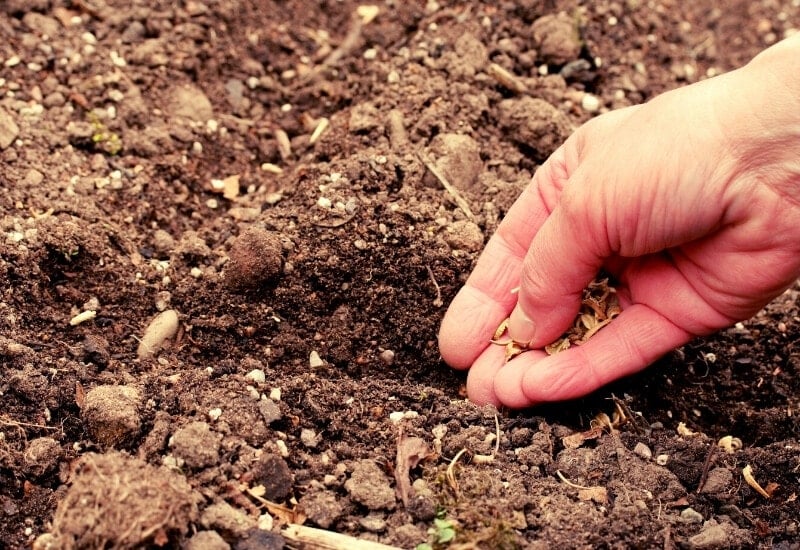
If you’ve never grown flowers from seeds, let marigolds be your first attempt. The flowers are fast-growing, so they make an excellent choice for beginners. The seeds should be sown after the dangers of the frost passes.
Place the seeds where you want them to grow. Either strew them by hand across a garden bed and let them pop up wherever, or place them right where they need to be. Marigold seeds germinate in just a few days with warm weather.
5. Plant Transplants Instead
Instead of starting marigolds from seeds, you can head to your local garden nursery and grab flats of marigolds for relatively cheap. They’re one of the cheapest flower seedlings to buy.
Transplant should be planted 10-12 inches apart. That seems like a large distance for small flowers, but marigolds bloom easily and spread out wide in good conditions.
After planting them in your garden, make sure to water well to hlep the roots start to establish.
4 Tips for Growing Marigolds in a Vegetable Garden

Caring for marigolds is easy; they require little work on your end. Here are a few tips to remember for ideal growth, but if you forget some of this, they’ll survive and thrive still.
1. Deadhead Often
It’s true that marigolds, unlike other flowers, don’t require deadheading, but it’s hardly a difficult task to complete. As you harvest vegetables throughout the garden, remove any deadheads from your marigold plants.
Deadheads are essentially spent, dead blooms. Grab them with two finger and gently pull; they pop right off. Frequently deadheading helps to encourage more blooms, leading to a bushier plant.
2. Don’t Overwater
It’s more important to avoid overwatering marigolds than it is to avoid underwatering. In between watering, let the soil dry out.
Then, water again. Always water at the base of the plant rather than watering the leaves. Excess water hitting the leaves will lead to powdery mildew.
3. Don’t Fertilize During Growth
The best time to fertilize marigolds is when you plant the seeds or seedlings. Too much nitrogen stimulates the plants to creatre more foliage rather than more flowers. You’ll end up with bushy marigolds full of leaves and just a few blooms.
4. Spread Out Mulch
It’s always a good idea to add a layer of mulch around your plants, including marigolds. Mulch helps to retain moisture and suppress weeds, making your life a little easier.
Since marigolds don’t like to be overwatered, mulch helps to reduce how often you need to water by slowing the evaporation process.
Try Growing Marigolds in Your Veggie Garden

Listen to experienced gardeners who say that growing marigolds with their vegetables is a great idea.
Not only does it deter pests from visiting your garden, but it also attracts pollinators. It’s worth trying to see if it makes a difference in your garden.

Written By
Bethany Hayes
Bethany is a suburban homesteader, growing over half of the vegetables, fruit, and herbs that her family of six needs each year. She raises chickens and homeschools her children. When she isn’t spending time tending to her garden, you can find her reading, crocheting, and canning.

Very enlightening on the cucumbers. This year was the best year we ever had. We have 6 cucumber plants and harvest between 8 to 10 cucumbers each day.